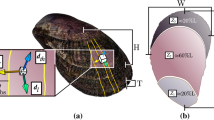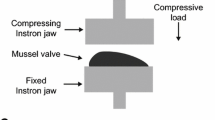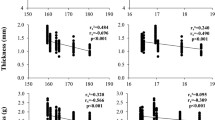Abstract
The specimens of Patella intermedia, Patella rustica, Patella ulyssiponensis and Patella vulgata were analysed for morphological and morphometric characters, and for the resistance to compression and crushing to a force applied at the apex. Shell shape in these species ranged from the high symmetrical cone, with a rounded base of P. rustica, to the flat, asymmetrical, narrow-pear-shaped base of P. ulyssiponensis. P. intermedia and P. vulgata showed intermediate morphologies. Shell thickness increased linearly with age, but differed in the four limpets. P. rustica had the thickest shells, and P. ulyssiponensis and P. vulgata had the thinnest shells. P. intermedia displayed intermediate shell thickness. Considering deformability and toughness, P. intermedia shells usually needed the highest force to compress in height, the highest pressure to collapse, and were appreciably deformed at collapse. On the opposite side, P. ulyssiponensis shells usually needed the lowest force to compress in height, the lowest pressure to collapse, and were much less deformed at collapse. P. intermedia shells were therefore the most deformable and tough, and P. ulyssiponensis, the most stiff and fragile. P. rustica and P. vulgata shells displayed intermediate behaviour. However, numerical simulations based on the finite element method using the experimentally determined shells’ geometry and thickness, but considering similar shells’ material and structure in the four species, predicted that shell toughness should be decreased in the order P. rustica >> P. intermedia > P. vulgata >> P. ulyssiponensis. P. rustica shells’ geometry (a high and centred cone) and thickness (very thick) were therefore, theoretically, the most fitted for shells to resist crushing by compression. Yet, in the experimental tests, they were not the most resistant shells. It was concluded that resistance to crushing was not a direct function of shell morphology and morphometry, but appeared to be mainly determined by shell deformability. This is most probably related to differences in the internal composition and architecture of the shell in the four species. By comparison with data reported in the literature on the pressures normally exerted by ocean waves, it was concluded that these limpets have resistances to crushing in far excess to pressures normally endured in nature, being therefore unlikely that these species are crushed by the action of even very strong waves on shores. Hard objects, like logs and boulders, can be hurled onto the shore by waves, and constitute a much greater threat to limpets than the waves themselves. The high toughness of the limpet shell can be related to resistance to the impact of incidental hard objects. There was no direct relationship between the habit preferences of these limpets and the resistance to crushing. Other factors are involved in the distribution of these species in the shores.









Similar content being viewed by others
References
Bird PAD, Crawford AR, Hewson PJ, Bullock GN (1998) An instrument for field measurement of wave impact pressures and seawater aeration. Coast Eng 35:103–122
Blackmore PA, Hewson PJ (1984) Experiments on full-scale wave impact pressures. Coast Eng 8:331–346
Branch GM, Marsh AC (1978) Tenacity and shell shape in six Patella species: adaptive features. J Exp Mar Biol Ecol 34:111–130
Cabral JP (2003) Characterization and multivariate analysis of Patella intermedia, Patella ulyssiponensis and Patella vulgata from Póvoa de Varzim (Northwest Portugal). Iberus 21:1–17
Cabral JP (2005) Concentration of metals in Patella intermedia, Patella rustica, Patella ulyssiponensis and Patella vulgata shells along the Portuguese continental coast. Boll Malacol 41:23–34
Christiaens J (1973) Révision du genre Patella (Mollusca, Gastropoda). Bull Mus Nat Hist Nat 182:1305–1392
Denny MW (1988) Biology and mechanisms of the wave-swept environment. Princeton University Press, Princeton
Denny MW, Blanchette CA (2000) Hydrodynamics, shell shape, behaviour and survivorship in the owl limpet Lottia gigantea. J Exp Biol 203:2623–2639
Ellem GK, Furst JE, Zimmerman KD (2002) Shell clamping behaviour in the limpet Cellana tramoserica. J Exp Biol 205:539–547
Evans RG (1947) Studies in biology of British limpets. Part I. The genus Patella in Cardigan Bay. Proc Zool Soc London 117:411–423
Evans RG (1953) Studies in the biology of British limpets—the genus Patella on the south coast of England. Proc Zool Soc London 12:357–376
Fisher-Piette E, Gaillard J-M (1959) Les Patelles, au long des cotres atlantiques ibériques et nord-marocaines. J Conchyliol 99:135–200
Fung YC, Tong P (2001) Classic and computational solid mechanics. World Scientific Publishing, Singapore
Grenon J-F, Walker G (1981) The tenacity of the limpet, Patella vulgata L.: an experimental approach. J Exp Mar Biol Ecol 54:277–308
Lowell RB (1985) Selection for increased safety factors of biological structures as environmental unpredictability increases. Science 228:1009–1011
MacClintock C (1967) Shell structure of patelloid and bellephontoid gastropods (Mollusca) Peabody Museum of Natural History, Yale University, Bulletin 22, New Haven Connecticut
Müller G, Whittaker TJT (1996) Evaluation of design wave impact pressures. J Waterway Port Coast Ocean Eng 122:55–58
Neves NM, Mano JF (2005) Strucutre/mechanical behaviour relationships in crossed-lamellar sea shells. Mater Sci Eng C 25:113–118
Peregrine DH (2003) Water-wave impact on walls. Annu Rev Fluid Mech 35:23–43
Ridgway SA, Reid DG, Taylor JD, Branch GM, Hodgson AN (1998) A cladistic phylogeny of the family Patellidae (Molusca: Gastropoda). Phil Trans R Soc London B 353:1645–1671
Rolán E, Otero-Schmitt J (1996) Guía dos moluscos de Galicia. Editorial Galáxia, Vigo
Smith AM (1992) Alternation between attachment mechanisms by limpets in the field. J Exp Mar Biol Ecol 160:205–220
Smith AM, Quick TJ, St Peter RL (1999) Differences in the composition of adhesive and non-adhesive mucus from the limpet Lottia limatula. Biol Bull 196:34–44
Vermeij GJ (1987) Evolution and escalation. An ecological history of life. Princeton University Press, Princeton
Vermeij GJ (1993) A natural history of shells. Princeton University Press, Princeton
Vogel S (1988) Life´s devices. The physical world of animals and plants. Princeton University Press, Princeton
Williams GA, Little C, Morritt D, Stirling P, Teagle L, Miles A, Pilling G, Consalvey M (1999) Foraging in the limpet Patella vulgata: the influence of rock slope on the timing of activity. J Mar Biol Ass UK 79:881–889
Zienkiewcz OC, Taylor RL (2005) The finite element method for solid and structural mechanics, 6th edn. Elsevier, Amsterdam
Acknowledgments
We are indebted to technician Rui Silva and Eng. Miguel Figueiredo for technical assistance in the crushing tests, and to Eng. Fernando Oliveira for helpful discussions.
Author information
Authors and Affiliations
Corresponding author
Additional information
Communicated by O. Kinne, Oldendorf/Luhe
Rights and permissions
About this article
Cite this article
Cabral, J.P., Natal Jorge, R.M. Compressibility and shell failure in the European Atlantic Patella limpets. Mar Biol 150, 585–597 (2007). https://doi.org/10.1007/s00227-006-0379-0
Received:
Accepted:
Published:
Issue Date:
DOI: https://doi.org/10.1007/s00227-006-0379-0




